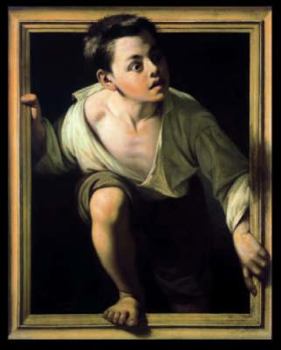A Trick of the Eye: Trompe L'Oeil Masterpieces
From its eye-popping cover to the last page, this collection of optical illusion, hyper-realism, and visual puns is a fun and fascinating exploration of five centuries of trompe l'oeil painting. Each... This description may be from another edition of this product.
Format:Hardcover
Language:English
ISBN:3791331639
ISBN13:9783791331638
Release Date:November 2004
Publisher:Prestel Publishing
Length:96 Pages
Weight:2.65 lbs.
Dimensions:0.8" x 9.9" x 12.5"
Customer Reviews
3 ratings
The best of Trompe l'oeil
Published by Thriftbooks.com User , 17 years ago
I've always had a passion for trompe l'oeil as the highest form of art. This book inspired me to add trompe l'oeil surprises throughout my book "The House that Faux Built: Transform Your Home with Paint, Plasters and Creativity The House That Faux Built We added a "broken glass" and painted corks on the stairs to the wine cellar, a matchbook on the dining room floor, trompe l'oeil clothes in the closet etc. Trompe l'oeil is fun and so is this book.
Fine Art taken to a new level
Published by Thriftbooks.com User , 18 years ago
This book is a good introduction to the incredible art of Trompe l'oeil, the purpose of which is to 'trick the eye' into believing that the two dimensional painting in front of you is actually a three dimensional object in space. The examples chosen here are fabulous representations of hyperrealistic art, ranging from 1660 A.D. to 1980. The authors start with the history, and then move on to different types of trompe l'oeil. This art of creating an illusion lives on even after the advent of photography, but it now takes various forms, such as sculptures, trick photography, murals on big buildings, and 'living art', a motionless person clothed as a sculpture, all of which are covered in the book. The pictures accompanying the history are small, but that is confined to the first 20 pages of the book. Each of the works featured is then explained in greater depth, illustrated by a full page reproduction, and some two-page close-ups views. Here you can see why trompe l'oeil art made people want to touch it, since they otherwise believed it was real! This illusion is especially true of big paintings like murals which create the illusion of space and depth so convincingly that the viewer believes the landscape is real. This book is a tribute to the amazingly painstaking work that artists have produced over the centuries. It is a book for people who love realistic art, and for those who appreciate the highest level of skill in any human endeavour.
The Paradox of the Hyper-Real
Published by Thriftbooks.com User , 19 years ago
The purpose of art is to depict reality. Or at least that is a purpose, and it was the main purpose before such talents as the Impressionists insisted that artistic expression was best displayed in dazzling colors and blurred shapes. The depiction in a painting was usually at some remove from reality; if you saw a painting of a landscape, for instance, you did not usually get the impression that the landscape was right there within the rectangular frame. Throughout the history of painting, however, there have been those who have gone for a higher level of realism, and paradoxically, a higher degree of deception, fooling the eye into thinking that what is painted is what is real. In _A Trick of the Eye: Trompe l'Oeil Masterpieces_ (Prestel), Eckhard Hollmann and Jürgen Tesch have collected fifty paintings (and sculptures) that demonstrate tricky artistry. It is a large format book, with twenty-four small reproductions to illustrate a useful essay on the history and range of the subject, and seventy pages of large reproductions of specific works with commentary. The covers of the book are particularly attractive. The front is entirely taken up with "Escape from Criticism," an 1874 painting of a picture in a frame; the frame is exactly the size of the book, and emerging from it is a boy, with a surprised look as if he is coming to life out of his oil painting. The back of the book is "Reversed Painting" of 1670, showing the wooden frame of a canvas, with tacks and even an auction number on it. My wife had already seen the book, but last night it was sitting on a table with the back up, and she was surprised to see that it was a book face down, not a painting face down. While I was writing this review, a friend came in and saw a lizard in the corner of an otherwise blank page, and was startled until she realized it was only printed there, a reproduction of a detail of an oil painting of 1660. Trompe l'oeil works. The tradition of trompe l'oeil goes back at least to ancient Greece. Hollmann and Tesch start their essay by retelling the legend of the painting competition between Zeuxis and Parrhasios. The judges were impressed that the grapes painted by Zeuxis were so real that birds flew down to peck at them. However, they found that Parrhasios had draped his entry in a curtain; when Zeuxis attempted to pull the curtain back, he only got fresh paint on his fingers. Guess who won the competition. Some of the paintings reproduced here have the same trick. "Still Life with Flowers" of 1658 is actually the work of two different artists, one an expert in painting flowers and the other an expert in painting fabric. There is a painting of an array of flowers in the main body of the painting, but there is also a painted rod at the top (held by painted hooks) from which a painted curtain is suspended, having been pulled to the right to reveal the "real" painting of the flowers. Frequent here are pictures of quodlibets; a quodlibet is like a





